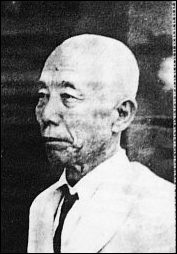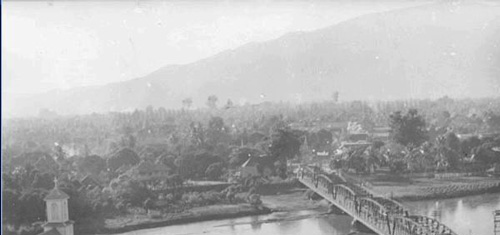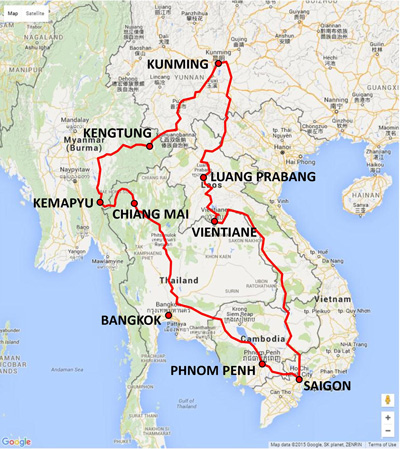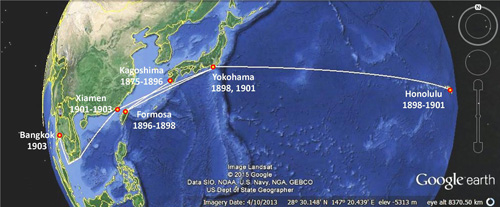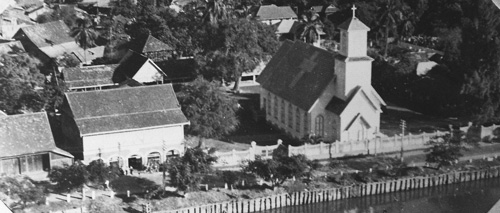Introduction
A lone reference tells of a Dane employed by the Thai government and living in Chiang Rai 1 at the beginning of WW2 who was apparently allowed to remain free and continue working during the war: 2
Bertel Thorvaldsen . . . worked as a colonel in the Thai Border Police under the Japanese occupation in World War II.
This situation seemed sufficiently unusual to justify research, and the results are provided below.
Background
King Chulalongkorn ruled Siam (Thailand) 1868 to 1910 and his reign is noted for, amongst other things, simplification of government organization with major reforms to its administration, including the standardization of law enforcement into a kingdom-wide gendarmerie 3
(per Wikipedia, “a gendarmerie is a military force with law enforcement duties among the civilian population”). 4
Both King Chulalongkorn and his half-brother, Prince Damrong, had visited Denmark in the 1890s and presumably were impressed with its so-called Blue Gendarmerie, which existed 1885–1894 to assist the Danish police in domestic security matters; and the concept was adopted by Siam’s Ministry of Interior in 1897. 5
From Wright in 1908 (emphasis added): 6
Outside the capital and the surrounding province the country is policed by the gendarmerie . . . There are no less than 345 stations scattered over the country, which serve as centres for the prevention and suppression of crime. . . . The work of administration is carried on by Siamese officers, who are assisted, at the present time, by thirteen Danish officers, as inspectors and instructors, stationed in the different circles according to the exigencies of the service.
The gendarmerie evolved in several integrations with other law enforcement units to eventually become today’s Royal Thai Police (RTP). 7 Under the umbrella of the RTP, the Border Patrol Police was established in 1951. 8

Bertel Thorvaldsen 1875-1957 10 11
Ten Danish army officers were initially recruited to assist the gendarmerie, one of them being Bertel Thorvaldsen, who arrived in Thailand in 1901, aged 26. Except for a two-year return to Denmark (1914-1916), Thorvaldsen served continuously in the gendarmerie until it was disbanded in 1926 because of economic difficulties in the kingdom. Early in his career in Thailand, he married a Thai of noble birth from Chiang Mai and eventually fathered ten children, the last born in 1932. 12 Effectively retired at age 51, but with a generous Thai government pension, he elected to remain in Thailand, settling in Chiang Rai where he had spent much of his career, and became involved in various pursuits, including a hotel, a tobacco farm, a bus service linking Chiang Rai and Lampang, an equipment parts shop, and a lumber mill.
Thorvaldsen’s success in business was matched by his seeing all ten children through university, with two winning major scholarships enabling study overseas. 13
In 1942, ie, early in WW2, Thorvaldsen, aged 66 and long retired, and conspicuous as a foreigner, caught the attention of the Imperial Japanese Army (IJA). Almost all foreigners, eg, in the north of Thailand, notably WAR Wood, aged 63 and long retired British Consul in Chiang Mai, 14 and William Bain, aged 59 and employed by the Borneo Company from Chiang Mai, 15 were relocated to detention camps near Bangkok for the duration of the war. However, a Thorvaldsen family history records that Chiang Rai officials successfully pled with IJA officials for Thorvaldsen’s freedom, citing his long service to Thailand. However, while granting his freedom, IJA officials required that he leave Chiang Rai. He chose to relocate to Bangkok where he rented a house for the duration of the war.
In the absence of its patriarch, the family carried on: the family history recalls that the eldest son, Alexander, in his 30s by that time, was active in the local Seri Thai and agreed to maintain a waystation for Seri Thai personnel coming into northwest Thailand by parachute or on foot from Kunming, China. He or someone else locally maintained radio communication with Allied forces in Kunming and the IJA eventually intercepted a wireless message which resulted in the IJA searching the Thorvaldsen house. While two of the children were terrified by the appearance of IJA soldiers at their door, an older daughter present, Christina, maintained her poise, sent a warning to Alexander at their tobacco farm where Seri Thai personnel were in hiding, and then welcomed the IJA in to successfully allay their suspicions. But the IJA did continue on to the tobacco farm, where Alexander succeeded in passing off the Seri Thai as ordinary farm employees. 16
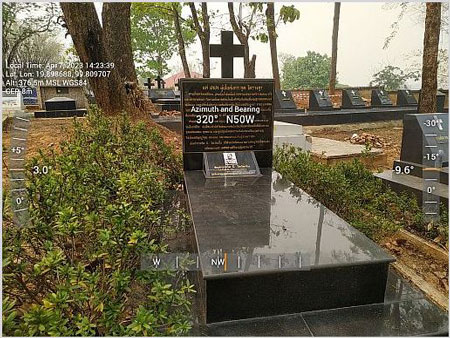 Thorvaldsen died in 1957 of cancer. He is buried in Nong Hiang Christian Cemetery at N19°53.921 E99°48.582. 17
Thorvaldsen died in 1957 of cancer. He is buried in Nong Hiang Christian Cemetery at N19°53.921 E99°48.582. 17
The inscription beneath the photo,
ผู่ริเริ่มนำความเจริญมาสูวงการตำรวงภาคเหนือ
reads approximately,
The man who guided the development of the police force in the Northern Region
Conclusions
The introductory statement taken from an obituary that told of Bertol Thorvaldsen / Thornagkul having worked in the Thai Border Police during WWII is not true. As noted, by the beginning of the war, he had been retired from government service for 16 years. Further, the Thai Border Police (Border Patrol Police) unit of the RTP was only established in 1951, well after the end of the war.
If Thorvaldsen was in fact not detained during the war as told in the family history, his freedom was perhaps unique amongst all nominally Western foreigners present in Thailand at the beginning of the war. His family history attributes his freedom to intercession by Chiang Rai officials on his behalf and the IJA honoring their request.
There is also a possibility that his Danish citizenship figured in a Japanese leniency towards him: since Denmark had been occupied by Germany in 1940, Denmark might have been considered an ally of Germany, which in turn was an ally of Japan, which in turn was an ally of Thailand. So, Thorvaldsen, a Dane, was a citizen of an ally of Japan. The same logic applied to the Japanese relationship with French civilians in Vichy French Indochina during most of WW2. 18
However, if, as the book states, the IJA merely banished Thorvaldsen from Chiang Rai, and apparently gave him a choice as to where else to live, it seems peculiar that he would have chosen to live as far away as Bangkok rather than, say, in Chiang Mai where he had numerous contacts with relatives of his wife (or a bit farther away in Lamphun where his father-in-law had resided).
An extreme alternate scenario is that Thorvaldsen went down to Bangkok, as did all other Westerners, to a detainment camp for the duration of the war. That fact might have been simply lost over time; or possibly the story of his freedom grew out of a misunderstanding; or perhaps Thorvaldsen prepared the story to keep his family from worrying about him during his absence.
Tangible evidence corroborating Thorvaldsen’s presence in Bangkok during the war and his circumstances there would provide support helpful to the family’s history.
Note of thanks
Special thanks to the following Thorvaldsen family members for their assistance, in order of our meeting with them:
Krongjit Thadadet who met us at the Work@Home Cafe, provided much family information, and gave us additional contacts.
Thorvald Thoravaldsen who promptly provided us a copy of the book on the Thorvaldsen family history.
Tawanchai Feungwatanapanit who was the main source to the author of the family history book, and who provided additional details by Line phone calls about the family.
| First published on Internet | ||
Last Updated on 29 February 2024
- N19°54.415
E99°49.995 Google Earth coordinates at Phahonyothin Rd “dogleg” in old Chiang Rai. Phahonyothin Road goes south from Chiang Rai to Lampang, with its rail connection to Bangkok, and north from Chiang Rai to Mae Sai on the border with Burma, and on by road to Kengtung in Shan State, Burma. [↩] - Find A Grave: Bertel Thornagkul.[↩]
-
WA Graham, Siam: A Handbook of Practical, Commercial, and Political Information (Chicago: Browne, 1913), pp 251-257.
Arnold Wright et al, Twentieth Century Impressions of Siam (London: Lloyd’s, 1908), pp 110-111.[↩]
- Wikipedia: Gendarmerie (accessed 01 May 2023).[↩]
- Scandasia: Lieutenant–Colonel August Theodor Frederic Kolls (1867-1911).[↩]
- Arnold Wright et al, ibid.[↩]
- Jessada Burinsuchat, Non-Traditional Security, International Police Cooperation and the Royal Thai Police (thesis) (Canberra: Australian National University, 2017), pp 117-119.[↩]
- Wikipedia: Border Patrol Police (accessed 04 May 2023).[↩]
- Laosunetaun, ibid, p 70, extract from family portrait.[↩]
- Thorvaldsen eventually changed his surname to Thorangkul and that is the surname of some of his male descendants. However, his gravestone reads Lt Col B Thorvaldsen. Alternate spellings include Thoransen and Thoravaldsen.[↩]
- Unless otherwise noted, the following relies on an informally published family history, ปาปา: ฌองดามรุ่นแรกชองสยามประเทส by ศาสตราจารย์ ดร. นิยะดา เหล่าสุนทร [Papa: First Gendarme of Siam by Niyada Laosunetaun, PhD]; research on Bertel Thorvaldsen is complicated by another Dane having the same name, who was famous as an internationally recognized sculptor from an earlier era: 1770-1844 (see Wikipedia: Bertel Thorvaldsen).[↩]
- He and his wife also took in and raised a child whose mother, a cousin of his wife, had died.[↩]
- Find A Grave: Dr Dana Thornagkul Lee and Find a Grave: Thora Purdom.[↩]
- The Chiang Mai Foreign Cemetery Committee, De Mortuis, 6th Edition (Chiang Mai: Within Design Co, 2009), p 94. [↩]
- Welcome to Chiangmai & Chiangrai: Wat Gate Museum (link to WayBack Machine).[↩]
- A map, titled “Underground-related locations in Thailand”, in Reynolds, E Bruce, Thailand’s Secret War (Cambridge: Cambridge, 2005), p 210, includes Chiang Rai; but no details are provided in the text.[↩]
- Photo: Dioptra view of grave of Lt Col B Thorvaldsen, 1875-1957.[↩]
- (reference needed).[↩]
